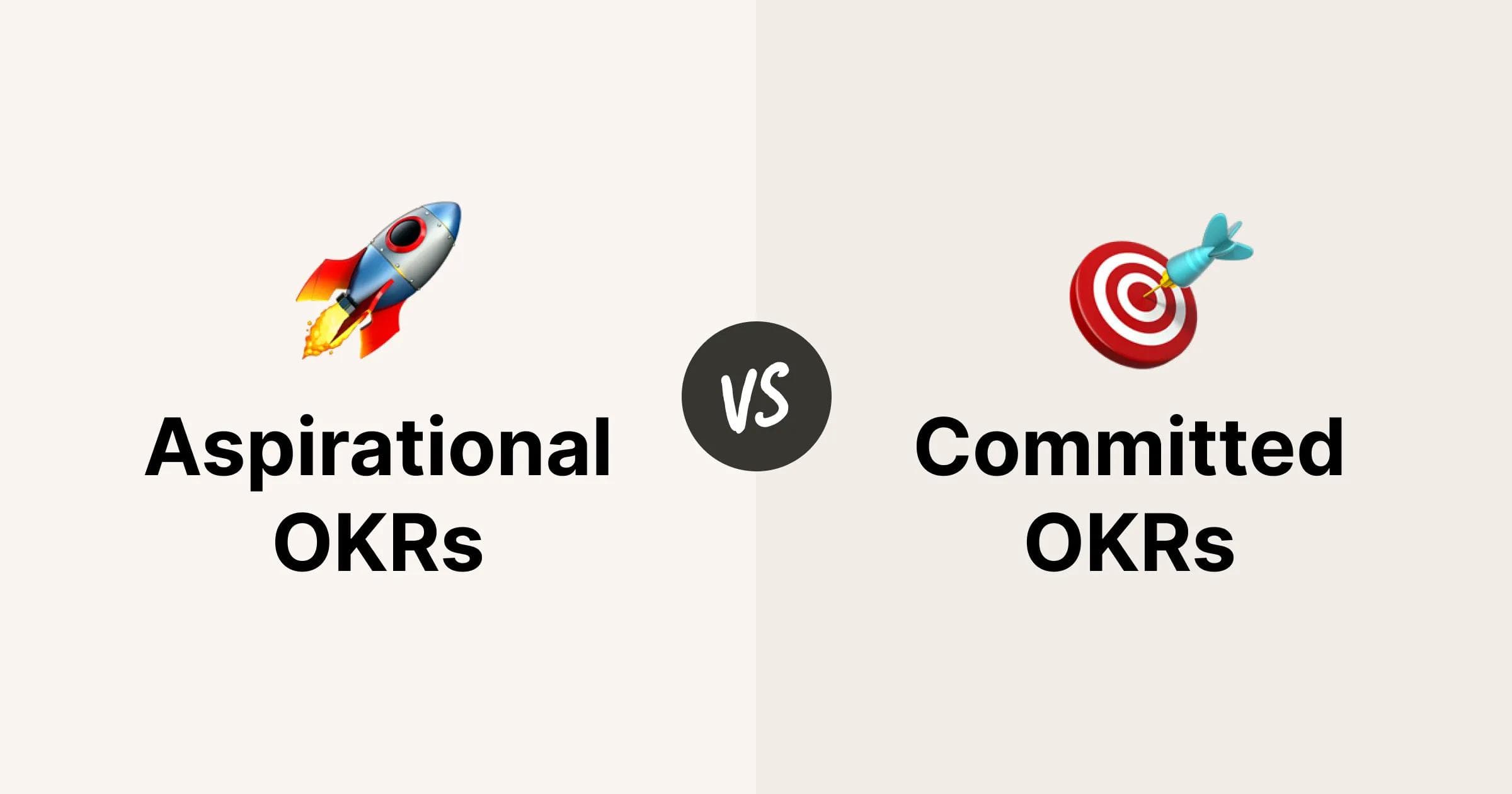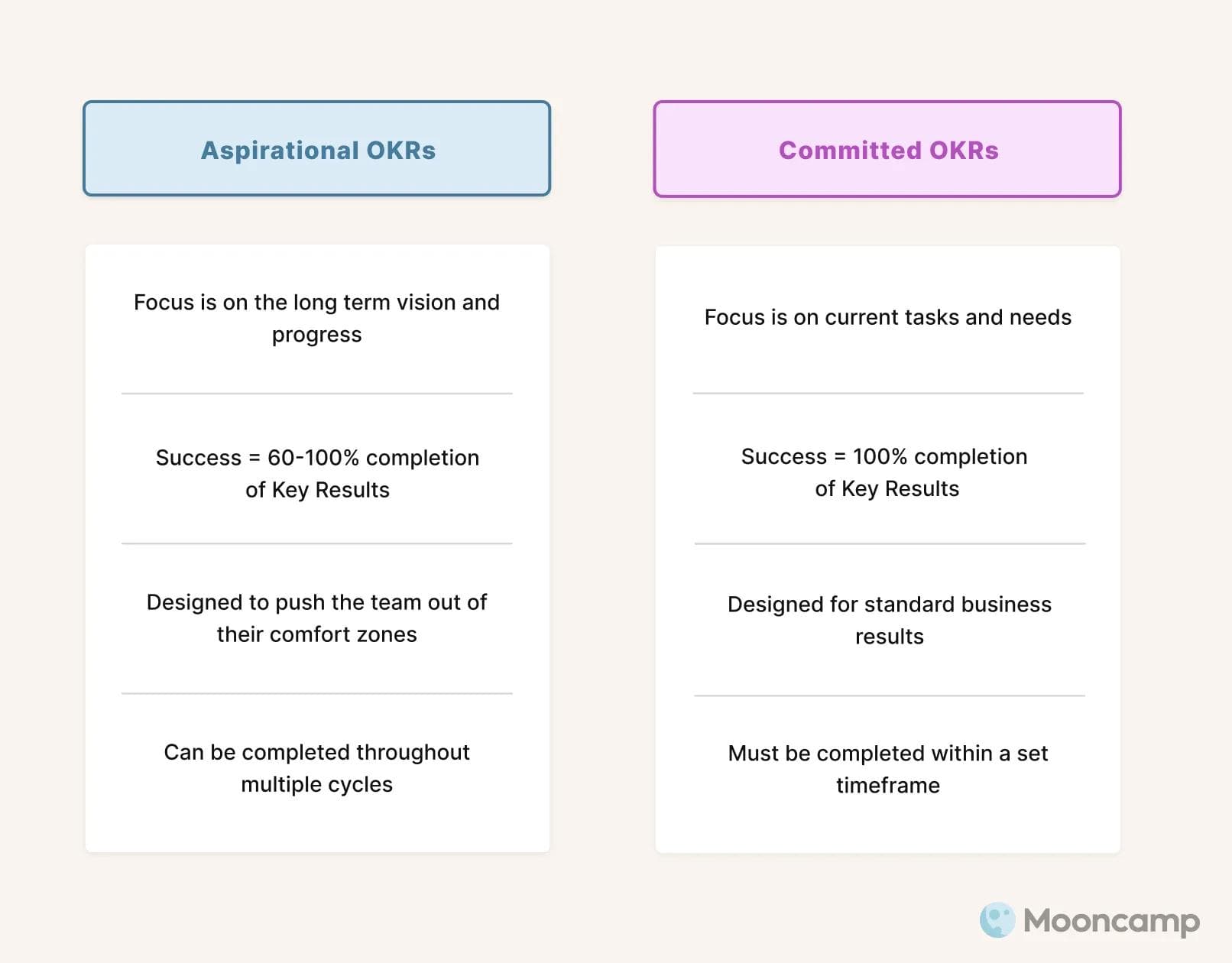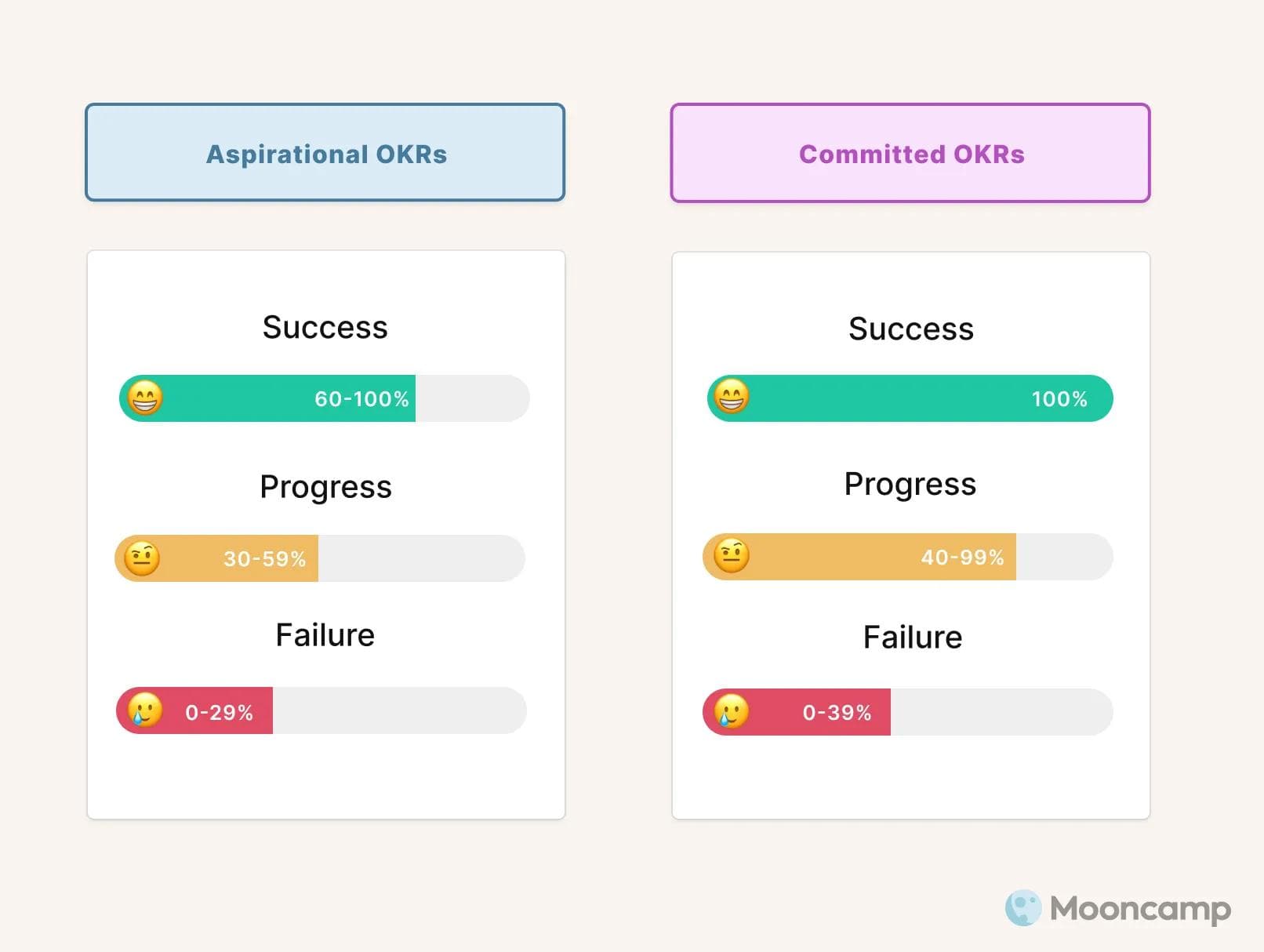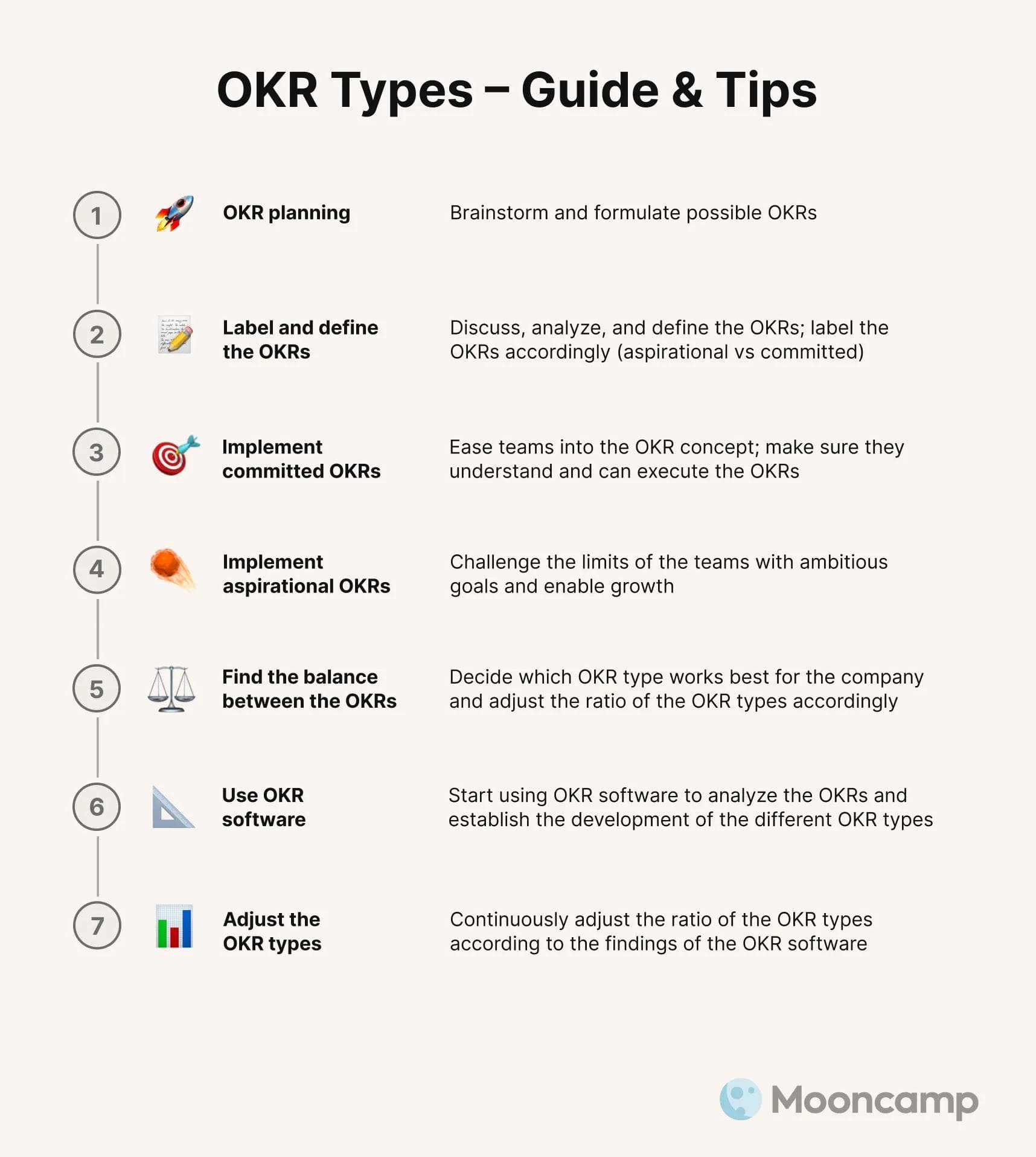Aspirational vs Committed OKRs: What’s the difference and how to balance them?

When using OKRs, there are two types of goals that one can set: committed and aspirational OKRs.
Understanding the difference between committed and aspirational OKRs can help companies use the OKR methodology according to their preferences, work pace, and ambitions. However, if the difference between the two OKR types is not clear, poor OKRs might be set and the OKR methodology might fail. Thus, properly understanding committed and aspirational OKRs is important.
This guide will clarify the difference between the two OKR types, explain when and how to use them, and lastly, dive into the benefits of OKR software when working with both goal types.
What to expect:
- What are committed and aspirational OKRs?
- How to grade committed and aspirational OKRs
- What are the benefits of committed and aspirational OKRs?
- Deciding between committed and aspirational OKRs
- Creating a balance between committed and aspirational OKRs
- Managing both OKR types with OKR software
- FAQ
What are committed and aspirational OKRs?
Committed OKRs, also known as roof shot goals, are demanding yet achievable goals that teams must complete within a given cycle. In this type of OKR, all Key Results must reach 100% completion within a set timeframe.
Designed to drive performance and tangible results, committed OKRs provide a clear road map regarding what should be focused on and which tasks should be prioritized. They tend to be specific yet challenging, as they push teams to stretch their capabilities while remaining realistic.
Committed OKRs also serve to motivate teams since regularly achieving goals boosts morale and can lead to newfound confidence, whereas always chasing hard-to-reach Objectives can result in unnecessary stress.
💡 Tip: If you would like to refresh your basic knowledge of the OKR framework in more detail, take a look at our OKR guide.
Committed OKR example:
Aspirational OKRs, otherwise known as moonshots, stretched, or 10x goals are the big, ambitious goals that a company or team sets for itself. They focus on the company’s vision and are intentionally designed to be very challenging, such that the team is not expected to fully achieve them within an OKR cycle. Instead, aspirational OKRs are meant to inspire teams to think creatively and aim high, as they focus on pushing the boundaries and striving for excellence.
Aspirational OKR example:
In sum, committed OKRs are the goals that teams need to achieve within a cycle. They focus on the high-priority Objectives that must be met to ensure the company’s or team’s success and consist of specific steps. Meanwhile, aspirational OKRs help teams make steady progress toward seemingly unachievable goals. They are the goals teams pursue in the hopes of driving innovation and growth forward.

What happens if OKRs are misclassified?
Misclassifying OKRs can have unintended consequences:
When you treat an aspirational OKR as committed:
- Teams may feel overwhelmed trying to meet a lofty goal as if it were a guaranteed target.
- If teams consistently fall short demotivation might ensue.
- Resources might be stretched thin chasing what's essentially a "moonshot”.
When you treat a committed OKR as aspirational:
- Essential, must-hit targets might be prolonged unnecessarily.
- Stakeholders expecting certain results can be disappointed.
- The company may miss out on critical, foundational achievements.
As seen, misclassifying OKRs can lead to wasted resources, unmet expectations, and demotivated teams. Understanding the difference between the two OKR types ensures that teams understand the level of priority and the expected outcomes. This also allows them to allocate their resources and focus accordingly.
Up next, we will take a closer look at the differences between the two OKRs.
Grading committed and aspirational OKRs
When it comes to committed and aspirational OKRs the grading process highlights a distinct difference between the two OKR types. An OKR’s grade or score is determined by averaging the scores of its Key Results. The OKR grading or scoring process provides insight into the progress and achievement levels of a particular objective. However, the scoring approach between committed and aspirational OKRs differs vastly.
Grading committed OKRs: These are goals you must achieve. When grading them you must think of them as non-negotiable – setting them implies reaching 100% completion. If you only achieve 80%, then you've fallen short of your Key Results and have failed to reach the OKR.
Grading aspirational OKRs: Aspirational OKRs are graded with the understanding that they are stretch goals. It's okay if you don't reach 100%. Even achieving 60% or 70% is considered a big win since the goal was meant to push you beyond your usual limits.

The different benefits of committed and aspirational OKRs
The two OKR types also offer different benefits.
For one, committed OKRs make sure teams concentrate on critical tasks where there is less room for failure. Their Objectives are specific and clearly state what needs to be achieved leaving no ambiguity about what needs to be done. This ensures that everyone takes responsibility for meeting the goal.
Roofshot goals also help companies use their resources wisely, as they are then divided across the top priority tasks. Furthermore, achieving or falling short of a committed OKR provides a clear indication of performance, allowing for quick adjustments if necessary. Lastly, when teams consistently pursue and complete these realistic goals, it boosts their spirits.
Committed OKRs benefits:
- Provide clarity and orientation
- Foster accountability
- Efficient allocation of resources
- Facilitate performance measurement and adjustments
- Increase morale
On the other hand, by setting ambitious targets, aspirational OKRs inspire teams, as they encourage them to think big.
When pursuing stretch goals, teams often push their boundaries and come up with creative solutions or new approaches. Thus, these goals push organizations to expand their horizons and grow beyond their current capacities, while setting the bar for performance higher than normal. They are meant to challenge the status quo, push teams to explore new possibilities, and change approaches.
Even if not fully achieved, aspirational OKRs promote a culture of continuous improvement and learning. In short, they spark innovation, drive growth, and inspire teams to reach beyond the ordinary.
Aspirational OKRs benefits:
- Inspire teams/individuals
- Prompt innovation
- Drive peak performance
- Encourage continuous improvement
Aspirational OKRs encourage teams to aim high and think creatively, while committed OKRs provide clear, achievable targets that are essential for the company’s success. Hence, by having both aspirational and committed OKRs, organizations can strike a balance between ambition and practical expectations.
Important: The balance between aspirational and committed OKRs varies based on the company's strategic priorities. In essence, the ratio required for balance can tilt based on what the company aims to achieve in a particular time frame. Because of this, one of the most important steps when working with the OKR framework is choosing the types of goals you would like to work with the most.
Next, we will explain how one can decide between committed and aspirational goals and how to strike a balance between the two OKRs.
Committed or aspirational OKRs?
The first thing to consider when choosing the OKR types is how familiar a company is with the OKR methodology. For companies new to OKRs, committed OKRs are a safer starting point. Why? Because they set clear, achievable targets that teams can easily grasp and achieve. Teams or companies with no or minimal OKR experience benefit from this straightforward approach. It builds confidence in the OKR system, ensures everyone's on the same page, and paves the way for more ambitious goals later on. Think of it as learning to walk before attempting to run. It’s a solid foundation for future success.
Once teams are better acquainted with OKRs, the implementation and execution of aspirational OKRs will also be easier. As such, most of the time, committed OKRs should be implemented before aspirational OKRs.
However, if you are already experienced with the OKR framework, deciding between the two OKR types requires a thorough understanding of the current phase, nature, and strategy of your organization.
Current phase of the organization
Aspirational goals are often more suitable for young companies. Young companies, especially startups, are in a phase where they aim for rapid growth. Aspirational goals push them to innovate and capture significant market share quickly. Additionally, companies that are just starting tend to be more flexible as they have less red tape than bigger, established ones. This makes it easier for them to quickly shift and chase ambitious goals.
As companies grow and mature the focus tends to shift towards committed OKRs to ensure steady growth and smooth operations. After all, risk-taking is essential for growth, but excessive risk can jeopardize the standing and market position of an established company. Thus, committed goals are the safer bet as they provide a clear roadmap to meeting expectations. Furthermore, larger companies have multiple departments, teams, and complex operations. Through committed goals the company can establish clear accountabilities, ensuring every unit knows what's expected of them and works in alignment.
Nature of the organization
If a company’s main focus is more about pushing boundaries and aiming for transformative growth, then aspirational OKRs are the way to go. Similarly, companies willing to embrace risk for potential large returns might also favor aspirational OKRs. The nature of the team also plays a big role, since aspirational OKRs only work if the team is creative, outgoing, and willing to try new ideas. They have to be able to work independently, fail, learn, adapt, and grow.
In contrast, those who are risk-averse or in a critical phase (like dealing with financial difficulties) may prioritize committed OKRs. Also, if a company or team is more focused on immediate success, such as hitting a quarterly sales target or maintaining a certain level of customer service, committed OKRs tend to be a better fit.
Strategy of the organization
The company’s current strategy also plays a big role in the decision.
Companies with strategies that have a high focus on innovation, like tech startups, might lean more towards aspirational OKRs to foster creativity and breakthroughs. But companies looking to maintain current success, following strategies that revolve around specific targets, for example, market penetration strategies, might opt for committed OKRs
As shown, certain OKR types are better suited for specific situations, companies, and teams. Regardless of the preferred OKR type, companies usually find the most value in a blend of both committed and aspirational OKRs. The ratio of committed to aspirational OKRs and vice versa is then adjusted according to their current strategic priorities and future aspirations.
Keep in mind: deciding between committed and aspirational OKRs is not a one-off process. It is necessary to regularly revisit your OKRs, aligning them with evolving company goals, team capacities, and changing strategies. Regularly readjusting the amount of committed or aspirational OKRs is the only way to create and foster a successful balance.
So how do you create a balance between the two OKR types?
Balancing committed and aspirational OKRs
While there isn't a one-size-fits-all answer, aligning OKRs with the company's strategy, educating the teams, fostering open communication, and regularly reviewing performance can help find an ongoing balance between aspirational and committed OKRs.
Educate and train
The first step in reaching a balance between the two OKR types is understanding the difference. It is crucial to ensure everyone understands the distinction between the two OKRs from the get-go. Only then can teams properly adjust their work approach according to the pursued OKR, identify and understand struggling OKRs, and find solutions to said problems.
Tip 💡 Regular OKR workshops, training sessions, and reading OKR books are a good way to educate teams on aspirational and committed OKRs.
Foster open communication
Teams and individuals can have valuable insights that help determine what's realistically achievable (committed) and what's a stretch but possible (aspirational). This helps determine what the OKR ratio for balance should be. Thus, it is important to foster a culture of open communication and engage the teams in the OKR implementation process.
Regularly review and adjust
A key factor to succeed with OKRs is reviewing and tracking progress. With weekly check-ins teams can regularly revisit their OKRs and update their performance data. This makes it easier to see how their OKRs have progressed and assess their outcomes in the OKR review.
Through the continuous data and progress tracking teams can then identify which OKRs they work best with and discuss what went well and what didn’t. For example, if data shows that aspirational OKRs are driving more innovation and positive outcomes, the team might decide to set more of them in the next cycle and vice versa. At the same time, if teams are consistently achieving their committed OKRs with ease, it may be time to introduce more aspirational ones. This way the ratio of OKRs can continuously be adjusted to the current situation, creating the optimal balance between the two OKR types.
Tip 💡 Recognize the effort put into aspirational OKRs, even if they aren't fully achieved. This can keep morale high and reinforces the idea that pushing boundaries and trying new things is valued.
Using OKR tools can also help organizations reach a balance.
Managing OKRs with Mooncamp
An OKR software, such as Mooncamp can be immensely helpful in managing both committed and aspirational OKRs. Here’s how Mooncamp can simplify the process:
- Visualization: One of the primary advantages of Mooncamp is its ability to visualize all progress through the OKR dashboard. One quick look at the dashboard reveals which goals are on track and which need special attention. This also makes it easier to identify what type of goal is succeeding or struggling the most. Hence, companies can easily see which goal type works best for them – making it easier to strike a balance between aspirational and committed OKRs.
- Progress Tracking: With Mooncamp, teams can regularly update their progress on specific Key Results. This real-time tracking helps organizations see if they're on pace to meet their committed OKRs and allows them to make adjustments if necessary. This way teams can quickly pinpoint problems and reallocate resources to ensure that the committed goals are met. It also shows them how close they are to achieving their aspirational OKRs, meaning they can then rewrite their aspirational OKR to resemble a committed OKR on time.
- Alignment: Mooncamp ensures alignment across teams and departments. It visualizes how individual and team OKRs map to larger organizational goals, enabling task and goal transparency. Through this, companies can ensure that everyone is working in tandem, whether towards aspirational goals or committed targets. What's more, is that this level of transparency allows for a greater level of flexibility as it helps teams quickly adjust their focus as needed and helps them understand the current phase, strategy, and goal of the company. Such transparency enables a harmonious balance between aspirational and committed OKRs.

Conclusion
Ultimately, aspirational OKRs inspire teams to aim high and think outside the box, while committed OKRs set clear, doable goals that guarantee success. Which OKR type works best depends on your company’s current phase, level of risk-aversion, and strategy. The preferred OKR type might also change over time, which is why OKRs should be reviewed and updated regularly.
More often than not, though, finding a balanced mix between the two OKR types is the best approach, as it allows companies to stay innovative and goal-oriented while also being practical and grounded.
FAQ
Can an aspirational OKRl become a committed OKR?
Yes, over time, as capabilities and resources expand, an aspirational goal might become more achievable and can transition to a committed goal.
What happens if a committed OKR is not met?
Missing a committed goal typically requires a detailed review to understand the reasons and make necessary adjustments. It might indicate a misalignment of resources, unforeseen challenges, or other issues.
How often should teams review aspirational and committed goals?
While specific review frequencies can vary, it's often recommended to review goals quarterly to assess progress and adjust strategies if necessary.
Common mistakes to avoid when setting committed and aspirational OKRs
Overly cautious aspirational OKRs:
When setting aspirational OKRs, don't just consider small incremental improvements. Aim high and envision the best possible outcomes. Aspirational goals should inspire and challenge beyond our current capabilities.
Undercommitting (Sandbagging):
If teams set OKRs that don't require most of their resources, it suggests they might be playing it safe. And if teams are easily meeting all their OKRs without fully using their team and budget, it can also mean that they are hoarding resources. Leaders might then think about reallocating these resources more efficiently.
Irrelevant Key Results for committed Objectives:
The Key Results should fully represent the Objective, especially when dealing with committed OKRs. If you can achieve all Key Results but still not meet the Objective, you might be missing some crucial Key Results.

